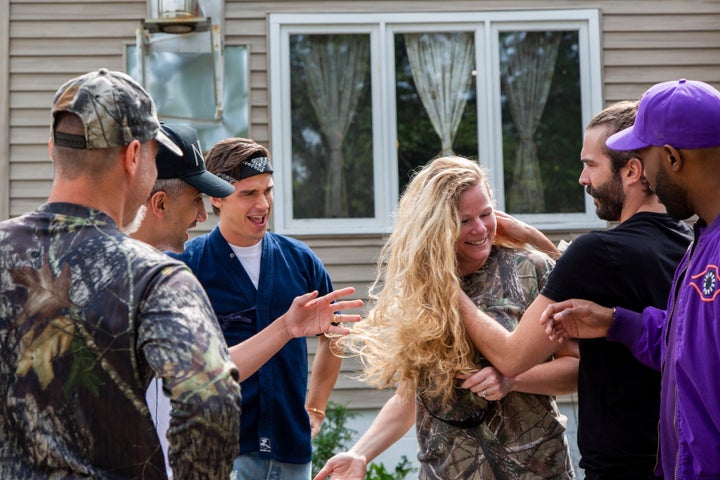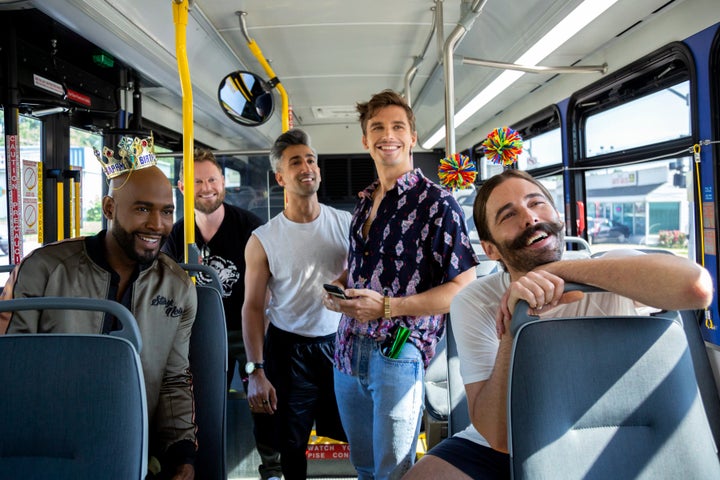“Queer Eye” returns to Netflix for a third season Friday, starting with a new episode that perfectly captures the subtle emptiness and frustrating facade of each episode’s makeover moment.
The very first makeover subject (or “hero,” as they are called in the show) of Season 3 states early on that she grew up poor. The episode ends with her eating a giant Maine lobster with her husband in a beautiful hotel room shortly after telling her stunned daughter, “I’m going shopping with you more often.” Regardless of the empowering messages that happen on the show’s margins, the “Queer Eye” makeover is defined, in this and previous seasons, by a hero essentially gaining the lifestyle of a rich person.
Before I go further, I should note that I love watching “Queer Eye” and even ranked it as one of 2018′s best Netflix shows. But whenever I more deeply examine the tear-inducing joy the show brings me when the heroes have a transformation, I can’t shake a feeling of being duped. This show may have an explicit message about inner empowerment, but implicitly all the transformation scenes are centered on turning the hapless heroes into wealthier (or wealthier-looking) versions of themselves. No amount of can-do attitude can achieve these results; only about six-figures in material upgrades can.
These makeovers showcase the heroes with new clothes, expensive haircuts and fancy skin lotions as they walk into an expensively renovated home to consume a meal that likely came from a Whole Foods-esque store.
With this in mind, all the asides about self-help and care seem insincere. The heroes aren’t choosing their own life renovations, which could narratively prove some actual change. The heroes just stumble into a whole new life of luxury and can only thank the hosts for the change in fortune.
Of course, anyone with a heart should still get something from watching down-on-their-luck people get shiny new things, but that’s a different show than what “Queer Eye” is billed as.
Marketing materials sent by Netflix state the narrative premise as, “This season, these fearless ambassadors of taste are headed to Kansas City to bring their infectious brand of self-love, confidence and encouragement to a whole new roster of heroes.” But rather than giving us stories truly rooted in self-improvement, “Queer Eye” falls into a trap many “makeover” shows fall into when trying to depict a visual transformation. Instead of inner triumph, we’re given the spectacle of someone experiencing a lottery windfall and finding happiness in the new things.

In the first episode of Season 3, the “Queer Eye” team transforms the life of Jody, a 49-year-old woman in Missouri who loves hunting and wearing camouflage. The show makes some attempt at politicizing the use of guns but ultimately lands at a shrug and an ethos of “you do you.”
After quickly shifting away from making the episode about guns, the narrative inertia of the episode becomes convincing Jody that, despite growing up with her brothers as “poor kids that lived on a farm,” she should acquire fancy things and tastes.
During her time with food expert Antoni Porowski, Jody says she doesn’t “feel comfortable going into a fancy restaurant.” Antoni responds that he doesn’t want Jody to use the word “fancy” anymore. “The word ‘fancy’ makes it sound like it’s elitist or wrong,” Antoni says. “I want to change the word to ‘special.’”
While getting her hair done by Jonathan Van Ness, the “Queer Eye” beauty expert pontificates on the importance of regular trips to grooming and pampering specialists. “I mean, it’s never fun, like, picking up an expense where you didn’t have one,” Ness tells Jody before suggesting going to a salon at least three times a year. In case this isn’t clear, “Queer Eye” doesn’t make over the lives of the already rich and doesn’t fund the heroes’ expensive new lifestyles after the cameras stop rolling.
For the climax of the episode, interior designer Bobby Berk unveils the massive home renovations he did, replete with all new furniture. Most striking is the subtle expensiveness of this new look. The camera never focuses on this, but the corners of the living room now have multiple tall cacti that easily cost hundreds of dollars apiece. For the casual viewer wondering why they can’t make their home look like the show with only a can-do attitude and belief-in-oneself, it’s because that’s not what “Queer Eye” actually sets out to accomplish beat-by-beat.
In an insult to the self-help booster “Queer Eye” claims to be, the first episode of Season 3 ends with Jody expressing that she finally believes she deserves nice things. She and her husband can eat “special” seafood with inner peace, because not believing in herself was totally the only thing holding Jody back from spending tons of money on dinner. The ending also features Jody telling her daughter she’s excited to go shopping with her. I really want to know the credit card debt these heroes amass after the “Queer Eye” team teaches them to spend, spend, spend, but stops footing the bills.

To its credit, “Queer Eye” has made an attempt to address this problem before. In Season 1, fashion expert Tan France went out of his way to find cheaper clothes for the hero, taking the hero and his kids to Target for some budget shopping (and sponsored content, which, speaking of that, the show is full of sponsored content moments). Predictably, that episode still climaxed with an insane home makeover.
The “Queer Eye” team of experts does have one hero adviser not directly tied to money in “culture expert” Karamo Brown. His self-help is much closer to the ostensible brand of the show, as he tends to put the hero through some sort of therapy session.
But it has taken a couple of seasons for Brown to find his footing in his inherently ill-fitting role given the show’s money-makeover format. Brown recently told amNewYork he felt “embarrassed” by his Season 1 performance. “It’s a visual medium, just like any television show,” Karamo said. “With a haircut by Jonathan, who has an amazing personality and also is an amazing stylist, it resonates quickly because you’re seeing someone’s hair change … but I’m having a conversation here, so where was the physical representation?”
By Season 3, Brown fares much better, but it’s still hard to think of his clips as something more than a transformation on the margins. The constraints of the show demand a visual metamorphosis by the end of each episode. Such transformations don’t come cheap. To credibly look new and improved, the heroes need to drip in the best of things and appear surrounded by an enviable new home. Finding inner strength and peace just doesn’t translate as well to the screen.

I still love “Queer Eye” and happily binged through the screeners Netflix made available to the media. The show makes me feel good inside in a way that’s rare for television shows. I still highly recommend you watch the new season when it premieres March 15.
At its true heart, “Queer Eye” may be a show about lavishing someone who doesn’t have much with gifts. That’s still a wonderful premise! But don’t feel bad when you can’t make over your own life in the same way.
And if you want to stay informed on what’s joining Netflix on a weekly basis, make sure to subscribe to the Streamline newsletter.
